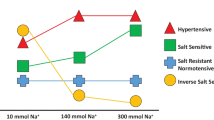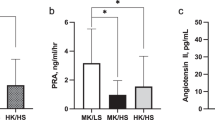Abstract
Introduction
Low-flow mediated constriction (L-FMC) has emerged as a valuable and complementary measure of flow-mediated dilation (FMD) for assessing endothelial function non-invasively. High dietary sodium has been shown to impair FMD independent of changes in blood pressure (BP), but its effects on L-FMC are unknown.
Purpose
To test the hypothesis that high dietary sodium would attenuate brachial artery L-FMC in salt-resistant adults.
Methods
Fifteen healthy, normotensive adults (29 ± 6 years) participated in a controlled feeding study. Following a run-in diet, participants completed a 7-day low sodium (LS; 20 mmol sodium/day) and 7-day high sodium (HS; 300 mmol sodium/day) diet in randomized order. On the last day of each diet, 24 h urine was collected and assessments of 24 h ambulatory BP and L-FMC were performed. Salt-resistance was defined as a change in 24 h ambulatory mean arterial pressure (MAP) between the LS and HS diets of ≤ 5 mmHg. Resting vascular tone and L-FMC were calculated from ultrasound-derived arterial diameters.
Results
High dietary sodium increased serum sodium and urinary sodium excretion (p < 0.001 for both), but 24 h MAP was unchanged (p = 0.16) by design. High dietary sodium augmented vascular tone (LS: 91 ± 23%, HS: 125 ± 56%, p = 0.01) and attenuated L-FMC (LS: − 0.58 ± 0.99%, HS: 0.17 ± 1.23%, p = 0.008).
Conclusion
These findings in salt-resistant adults provide additional evidence that dietary sodium has adverse vascular effects independent of changes in BP.



Similar content being viewed by others
Abbreviations
- BP:
-
Blood pressure
- DBP:
-
Diastolic blood pressure
- ECG:
-
Electrocardiogram
- EDHF:
-
Endothelium-derived hyperpolarizing factor
- ET-1:
-
Endothelin-1
- FMD:
-
Flow-mediated dilation
- HS:
-
High sodium
- L-FMC:
-
Low-flow mediated constriction
- LS:
-
Low sodium
- MAP:
-
Mean arterial pressure
- NO:
-
Nitric oxide
- PGI2 :
-
Prostacyclin
- SBP:
-
Systolic blood pressure
- TXA2 :
-
Thromboxane A2
References
Aizawa K, Elyas S, Adingupu DD, Casanova F, Gooding KM, Strain WD, Gates PE (2016) Reactivity to low-flow as a potential determinant for brachial artery flow-mediated vasodilatation. Physiol Rep 4(12):1–8
Anderson EA, Mark AL (1989) Flow-mediated and reflex changes in large peripheral artery tone in humans. Circulation 79(1):93–100
Bell PL, Kelley ET, McCoy SM, Credeur DP (2017) Influence of aerobic fitness on vasoreactivity in young men. Eur J Appl Physiol 117:2075–2083
Black CD, Vickerson B, McCully KK (2003) Noninvasive assessment of vascular function in the posterior tibial artery of healthy humans. Dyn Med 2(1):1–7
Boegehold MA (1995) Flow-dependent arteriolar rats fed low- or high-salt dilation diets in normotensive. Am J Physiol Heart Circ Physiol 269(38):H1407–H1414
Cavka A, Cosic A, Jukic I, Jelakovic B, Lombard JH, Phillips SA, Drenjancevic I (2015) The role of cyclo-oxygenase-1 in high-salt diet-induced microvascular dysfunction in humans. J Physiol 593(24):5313–5324
Dawson EA, Alkarmi A, Thijssen DHJ, Rathore S, Marsman DE, Timothy CN, Green DJ (2012) Low-flow mediated constriction is endothelium-dependent: effects of exercise training after radial artery catheterization. Circ Cardiovasc Interv 5(5):713–719
Dickinson KM, Clifton PM, Keogh JB (2011) Endothelial function is impaired after a high-salt meal in healthy. Am J Clin Nutr 93:500–505
DuPont JJ, Greaney JL, Wenner MM, Lennon-Edwards SL, Sanders PW, Farquhar WB, Edwards DG (2013) High dietary sodium intake impairs endothelium-dependent dilation in healthy salt-resistant humans. J Hypertens 31(3):530–536
Edwards DG, Farquhar WB (2015) Vascular effects of dietary salt. Curr Opin Nephrol Hypertens 24(1):8–13
Elliott P, Stamler J, Nichols R, Dyer AR, Stamler R, Kesteloot H, Marmot M (1996) Intersalt revisited: further analyses of 24 hour sodium excretion and blood pressure within and across populations. BMJ 312(7041):1249–1253
Förstermann U, Münzel T (2006) Endothelial nitric oxide synthase in vascular disease. Circulation 113:1708–1715
Gori T, Dragoni S, Lisi M, Di Stolfo G, Sonnati S, Fineschi M, Parker JD (2008) Conduit artery constriction mediated by low flow. A novel noninvasive method for the assessment of vascular function. J Am Coll Cardiol 51:1953–1958
Goto K, Kansui Y, Oniki H, Ohtsubo T, Matsumura K, Kitazono T (2012) Upregulation of endothelium-derived hyperpolarizing factor compensates for the loss of nitric oxide in mesenteric arteries of dahl salt-sensitive hypertensive rats. Hypertens Res 35:849–854
Greaney JL, Dupont JJ, Lennon-Edwards SL, Sanders PW, Edwards DG, Farquhar WB (2012) Dietary sodium loading impairs microvascular function independent of blood pressure in humans : role of oxidative stress. J Physiol 590(21):5519–5528
Harrison M, Parkhurst K, Tarumi T, Lin HF, Tanaka H (2011) Low flow-mediated constriction: prevalence, impact and physiological determinant. Clin Physiol Funct Imaging 31:394–398
Haynes W, Webb D (1994) Contribution of endogenous generation of endothelin-1 to basal vascular tone. Lancet 344(8926):852–854
Jablonski K, Racine M, Geolfos C, Gates P, Chonchol M, McQueen M, Seals D (2013) Dietary sodium restriction reverses vascular endothelial dysfunction in middle-aged/older adults with moderately elevated systolic blood pressure. J Am Coll Cardiol 61(3):335–343
Kuller LH (1997) Salt and blood pressure: population and individual perspectives. Am J Hypertens 10:29S–36S
Lenda DM, Sauls BA, Boegehold MA (2000) Reactive oxygen species may contribute to reduced endothelium-dependent dilation in rats fed high salt. Am J Physiol Heart Circ Physiol 279:H7–H14
Lennon-Edwards S, Ramick MG, Matthews EL, Brian MS, Farquhar WB, Edwards DG (2014) Salt loading has a more deleterious effect on flow-mediated dilation in salt-resistant men than women. Nutr Metab Cardiovasc Dis 24(9):990–995
Levenson J, Simon A, Pithois-Merli I (1987) Brachial arterial changes in response to wrist occlusion in normotensive and hypertensive men. Am J Physiol 253(2 Pt 2):H217–H224
Ramick MG, Brian MS, Matthews EL, Patik JC, Seals DR, Lennon SL, Edwards DG (2019) Apocynin and tempol ameliorate dietary sodium-induced declines in cutaneous microvascular function in salt-resistant humans. Am J Physiol Regul Integr Comp Physiol 317:H97–H103
Robinson AT, Edwards DG, Farquhar WB (2019) The influence of dietary salt beyond blood pressure. Curr Hypertens Rep 21:42
Sandoo A, Veldhuijzen van Zanten JJCS, Metsios GS, Carroll D, Kitas GD (2010) The endothelium and its role in regulating vascular tone. Open Cardiovasc Med J 4(1):302–312
Sofola OA, Knill A, Hainsworth R, Drinkhill M (2002) Change in endothelial function in mesenteric arteries of Sprague-Dawley rats fed a high salt diet. J Physiol 543(1):255–260
Strazzullo P, D’Elia L, Kandala N-B, Cappuccio FP (2009) Salt intake, stroke, and cardiovascular disease: meta-analysis of prospective studies. BMJ 339:b4567
Thijssen DHJ, Black MA, Pyke KE, Padilla J, Atkinson G, Harris RA, Green DJ (2011) Assessment of flow-mediated dilation in humans: a methodological and physiological guideline. Am J Physiol Heart Circ Physiol 300(1):H2–H12
Tuomilehto J, Jousilahti P, Rastenyte D, Moltchanov V, Tanskanen A, Pietinen P, Nissinen A (2001) Urinary sodium excretion and cardiovascular mortality in Finland: a prospective study. Lancet 357:848–851
Tzemos N, Lim PO, Wong S, Struthers AD, Macdonald TM (2008) Adverse cardiovascular effects of acute salt loading in young normotensive individuals. Hypertension 51:1525–1530
US Department of Health and Human Services and US Department of Agriculture (2015) Dietary Guidelines for Americans, 8th edn. US Department of Agriculture, Washington. Available at https://health.gov/our-work/food-and-nutrition/2015-2020-dietary-guidelines/
Vallance P, Collier J, Moncada S (1989) Effects of endothelium-derived nitric oxide on peripheral arteriolar tone in man. Lancet 2:997–1000
Weinberger M (1996) Salt sensitivity of blood pressure in humans. Hypertension 27:481–490
Acknowledgements
This research was supported by an NIH Grants R01 HL104106 and P20 GM113125.
Author information
Authors and Affiliations
Contributions
SLL, WBF, DGE conceived and designed research; MGR and NS performed experiments and/or analyzed data; NS and DGE interpreted results of experiments; NS drafted manuscript and prepared figures; NS and DGE edited and revised manuscript. All authors read and approved the manuscript.
Corresponding author
Ethics declarations
Conflict of interest
The authors have no conflicts of interest to disclose.
Additional information
Communicated by Westerterp/Westerblad.
Publisher's Note
Springer Nature remains neutral with regard to jurisdictional claims in published maps and institutional affiliations.
Rights and permissions
About this article
Cite this article
Shenouda, N., Ramick, M.G., Lennon, S.L. et al. High dietary sodium augments vascular tone and attenuates low-flow mediated constriction in salt-resistant adults. Eur J Appl Physiol 120, 1383–1389 (2020). https://doi.org/10.1007/s00421-020-04370-0
Received:
Accepted:
Published:
Issue Date:
DOI: https://doi.org/10.1007/s00421-020-04370-0




